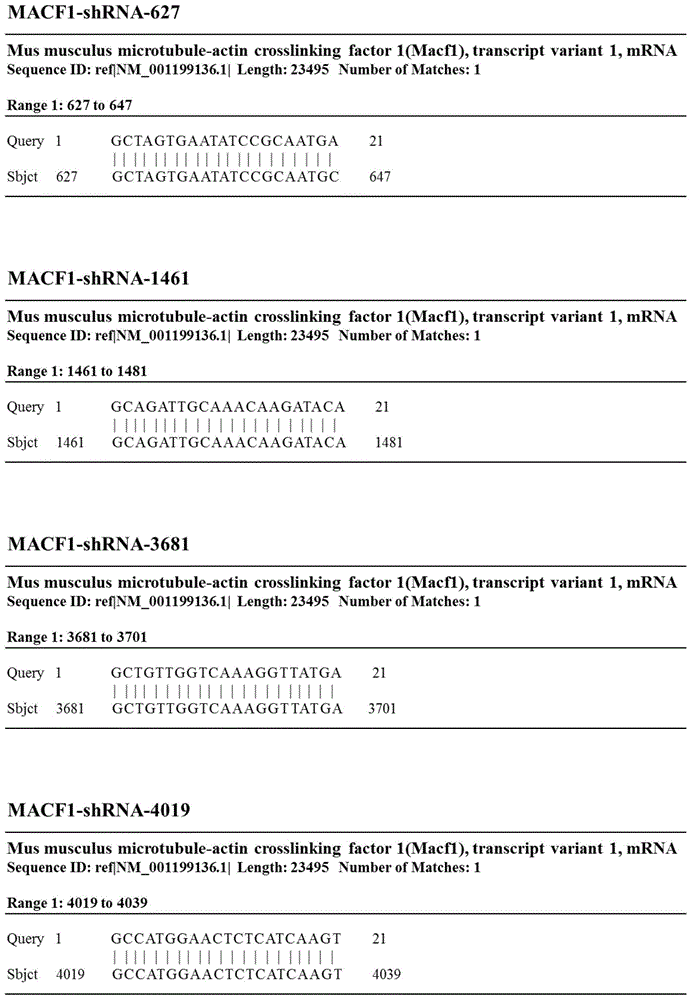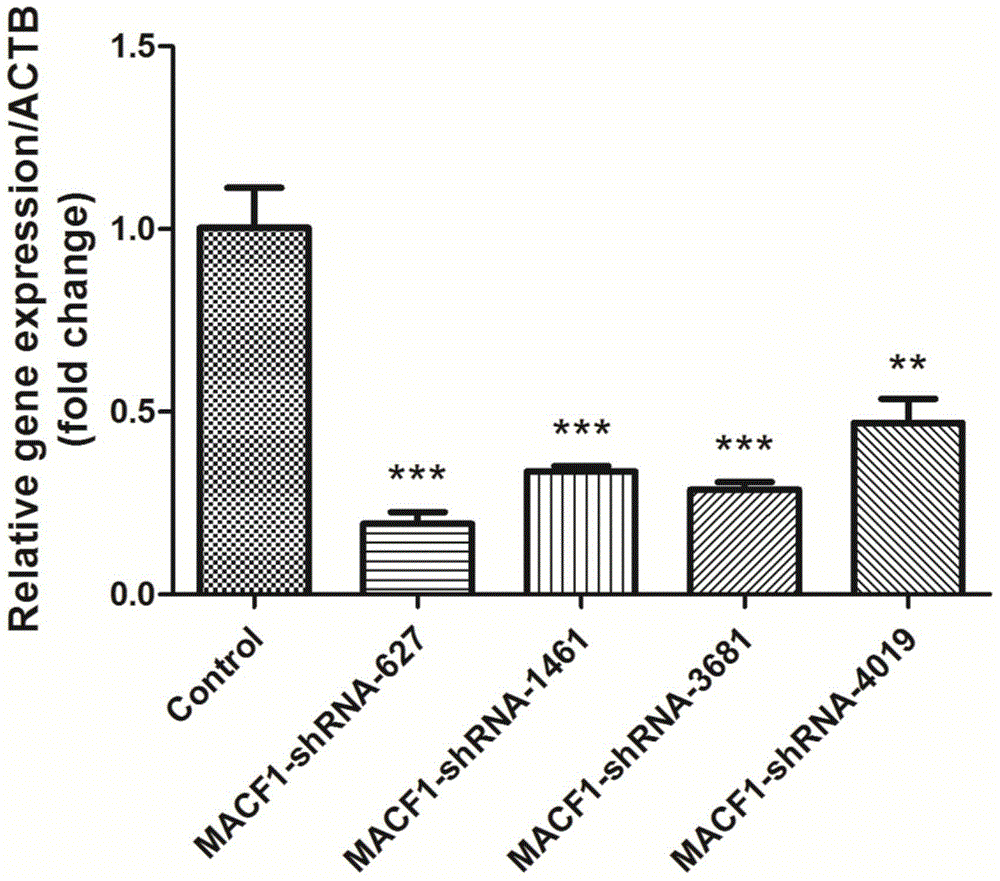Shrna sequence and application thereof for inhibiting expression of mouse macf1 gene
A gene expression and mouse technology, applied in the field of shRNA sequence, can solve the problem of low efficiency and achieve the effect of improving efficiency
- Summary
- Abstract
- Description
- Claims
- Application Information
AI Technical Summary
Problems solved by technology
Method used
Image
Examples
Embodiment 1
[0031] Example 1. Design and synthesis of shRNA sequences.
[0032] (1) Query the mRNA information of the mouse MACF1 gene through the GeneBank database (http: / / www.ncbi.nlm.nih.gov / genbank), and design 4 MACF1-shRNAs targeting the mouse MACF1 gene according to the shRNA design principle sequence, such as figure 1As shown, an irrelevant control shRNA sequence was designed at the same time as the control group (Control). The above designed shRNA sequences were synthesized by Shanghai Gemma Pharmaceutical Technology Co., Ltd. The four shRNAs target the 627, 1461, 3681 and 4019 positions of the mouse MACF1 gene (NM_001199136.1), respectively, and are 21 bases long.
[0033] Wherein, the action site sequence of MACF1-shRNA-627 involved in the present invention is:
[0034] 5'-GCTAGTGAATATCCGCAATGA-3';
[0035] The action site sequence of MACF1-shRNA-1461 is:
[0036] 5'-GCAGATTGCAAACAAGATACA-3';
[0037] The action site sequence of MACF1-shRNA-3681 is:
[0038] 5'-GCTGTTGG...
Embodiment 2
[0069] Example 2. Efficiency of Recombinant Lentiviral Vectors Infecting Mouse Preosteoblasts.
[0070] The lentiviral particles expressing the above four kinds of shRNA and Control-shRNA were transfected into mouse preosteoblast MC3T3-E1, and the infection efficiency of different shRNA sequences was detected by fluorescence microscopy.
[0071] (1) Experiment grouping: the experiment was divided into control group (Control), MACF1-shRNA-627 infection group, MACF1-shRNA-1461 infection group, MACF1-shRNA-3681 infection group, MACF1-shRNA-4019 infection group, a total of 5 groups , the number of cells and culture conditions were the same for all groups.
[0072] (2) Cell infection experiment method: mouse preosteoblast MC3T3-E1 was mixed with 1×10 6 Cells / well were seeded in a 6-well plate and mixed at 37°C in 5% CO 2 Cultivate for 24 hours; take 200 μl of lentivirus stock solution, dilute it 5 times with α-MEM medium containing 10% FBS, and add polybrene (Polybrene) with a f...
Embodiment 3
[0074] Example 3. Inhibition of MACF1 gene expression in mouse preosteoblasts by recombinant lentiviral vectors.
[0075] Real time PCR was used to detect the effects of four shRNAs on the expression level of MACF1 gene in mouse preosteoblasts.
[0076](1) Experiment grouping: the experiment was divided into control group (Control), MACF1-shRNA-627 infection group, MACF1-shRNA-1461 infection group, MACF1-shRNA-3681 infection group, MACF1-shRNA-4019 infection group, a total of 5 groups , the number of cells and culture conditions were the same for all groups.
[0077] (2) RNA extraction and real time PCR detection: After the cells were infected for 96 hours, the cells were lysed with Trizol, and the total RNA of each group of cells was extracted by the chloroform-isopropanol method, and the extracted mRNA was reverse-transcribed into cDNA. For: 42°C 30min; 85°C 10min. The cDNA of each group of cells was used as a template, ACTB was used as an internal reference, and Real tim...
PUM
 Login to View More
Login to View More Abstract
Description
Claims
Application Information
 Login to View More
Login to View More - R&D
- Intellectual Property
- Life Sciences
- Materials
- Tech Scout
- Unparalleled Data Quality
- Higher Quality Content
- 60% Fewer Hallucinations
Browse by: Latest US Patents, China's latest patents, Technical Efficacy Thesaurus, Application Domain, Technology Topic, Popular Technical Reports.
© 2025 PatSnap. All rights reserved.Legal|Privacy policy|Modern Slavery Act Transparency Statement|Sitemap|About US| Contact US: help@patsnap.com



